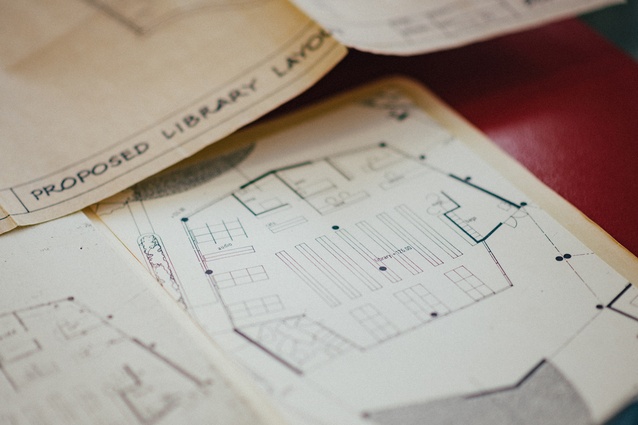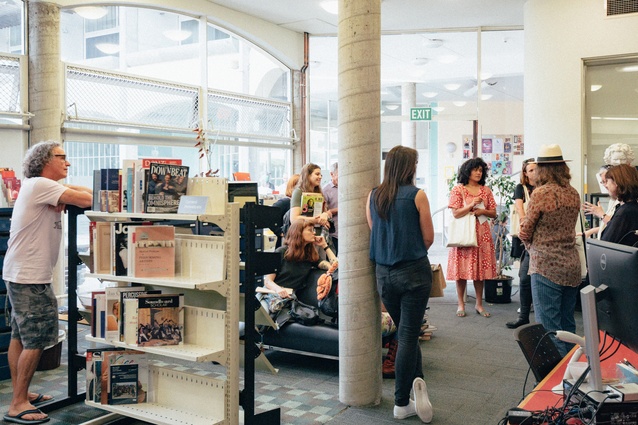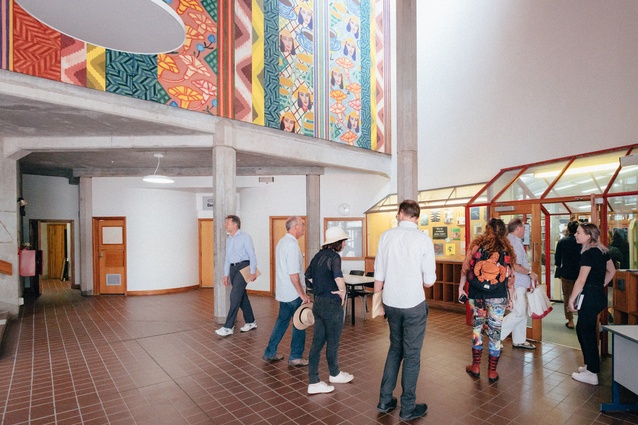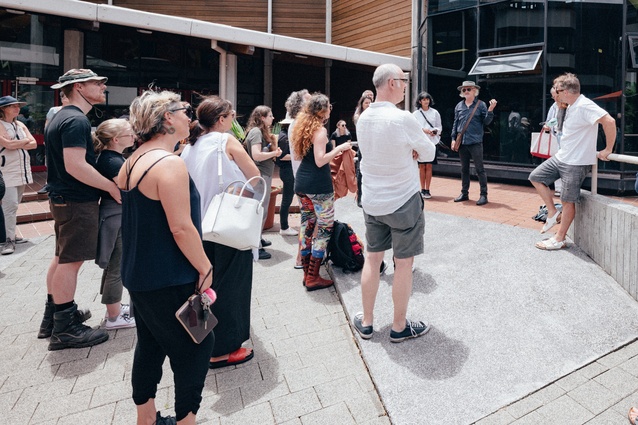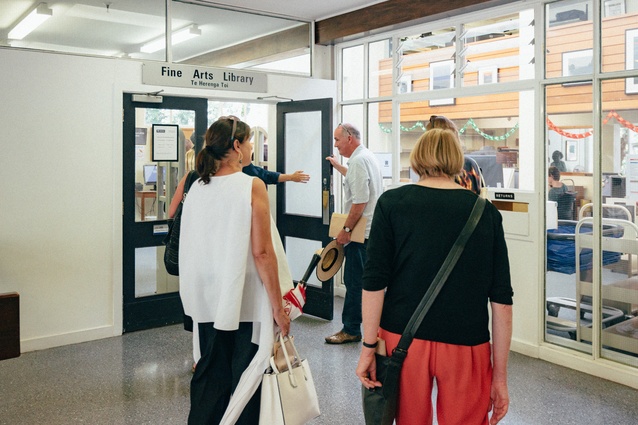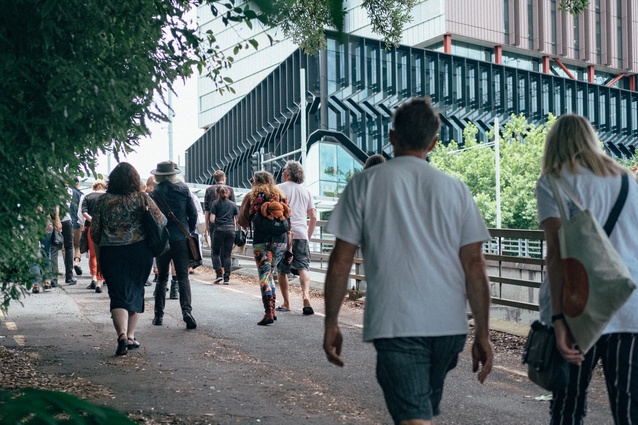Ex Libris: In honour of three specialist libraries
Icao Tiseli is a recent architecture graduate from the University of Auckland. She attended a tour of three soon-to-close specialist libraries, organised by Objectspace gallery to run in conjunction with their Ex Libris exhibition honouring the spaces. Here, Tiseli reflects on the physical structure of the buildings and what the closures mean for our future.
What breathes different lives,
Hosts many worlds,
But enters and ends in one place?
On a Thursday afternoon, walking up a pebbled pathway in between mature oak and bamboo, a sloped walkway reveals an enclave of light and greenery. This is the entrance to the Elam Library. Surrounded by trees and plants, one begins to see the sheer width of the building. The horizontal line of the structure spans over the slope of the hill, a solid, unmoving mass slotted into the ground. Precast concrete fins project from the front facing walls; sandwiched between them are 16 tall, slim windows casting diagonal shadow onto the spaces in between. A sliver of corrugated roofing can be seen atop the building from the entrance.
Delicious lines puncture, expand and extend a warm welcome to us as we begin our walk through three of the University of Auckland’s specialist libraries, which are soon to be shut down. In rare form, the sun is present, casting a radiant glow onto the building and its admirers. Graeme Burgess begins the tour with a Karakia and a welcome into the Fine Arts Library. He christens the start of our walk with a warm stream of memories, guiding us through history, weaving among shelves and walls, resurrecting the structure as the protagonist in our eyes.
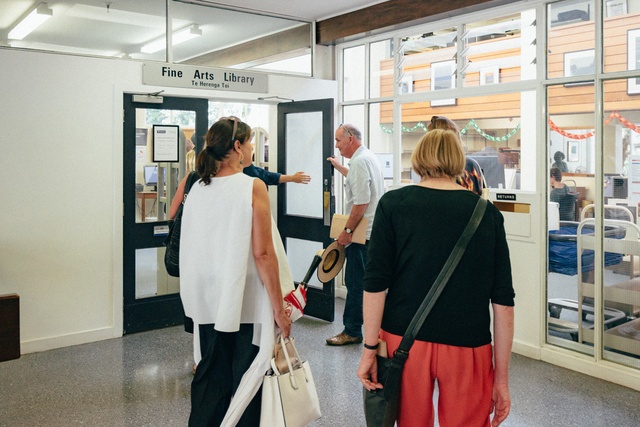
As one dips into the enclosed interior of the foyer, the engineering building merges into the architecture faculty. We make our way down the tiled maroon steps, looked over by colourful murals. The vibrance of the colours and imagery almost leaps from the walls as Graeme speaks to the collaboration of student and teacher on this piece. Scenes of the glaring sun and paint-stained hands – fading imprints of older days pulsing with the charged energy youth – leave a lovely note in the air.
Through inconspicuous, wooden-framed glass doors, the entrance of the Architecture and Planning Library opens up into a voluminous open space. Light streams filter onto the vertical precast concrete wall as the tiered roof opens up to ribbons of windows, sending sunlight into the space and warming the wooden beams and bookshelves with a buttery glow. The horizontal plane of the shelves sprouts a garden of architectural models, a repository of student efforts, expanding and projecting above and across each shelf.
The celebration of art and architecture is held so thoughtfully by this building. It begins on the end of each shelf and spills onto its walls. They become moments that reveal themselves as one introspectively wonders through this place. Wooden desks line the wall sitting beside large glass windows overlooking the engineering school’s courtyard. These desks are completely obscured from sight at the entrance by thick streams of book shelves; another treasured moment that unfolds as you choose to explore.

Making our way underneath the oak trees that line Symonds street, we arrive at our final destination: the Music and Dance Library. Basking in the boldness of its very own light, a mustard wall undulates as it stands in curved motion. A white classical portico sits in front of the wall leading into the entrance of the building. Walking down the enclosed entrance reveals a central courtyard with wide, shallow steps that descend down into benches underneath broad-brimmed umbrellas.
The library and studios look onto the centre, encasing the charming space with sound vibrating through the walls. This library is smaller and intimate, unlike the others. It offers perspex cubicles that line one side of the building: spaces that are dedicated to listening and researching musical theory. Beside them are bookshelves with volumes pertaining to classical and musical history, leading to desks placed alongside the large glass windows overlooking the courtyard. These work spaces sit against the curve of the structure, accentuating the natural swerves and movement this building holds.
Elegant gestures of the curved walls that wave into shaping the space demonstrate a strong connective core driven by music. Sound becomes an enticing participant throughout the day, from the busy commute of traversing along Symonds street into the quietness of the library, opening to the operatic trainings in a studio overheard from the courtyard. Music is positioned in this place as a celebrated, immersive experience nurtured by the spaces held within.

The more I learn about architecture, the more architecture reveals itself to be storytelling made visible. Libraries are the very home of stories and these buildings host years of volumes within their structures. While on this walking tour, there were moments where the realisation of this convergence caused emotion to bubble to the surface: the emotion of seeing the libraries as a flood of lived in memories.
These buildings are an inheritance that we are offered and, in turn, they become a valuable repository of memories hosting great insight into our very own history. The construction of these places demonstrates methods and techniques that belonged to a period of their own, and it is that layering of time and vision that makes these spaces extremely valuable in our society.
It is what libraries represent: they become monuments in our life that give knowledge, shelter and time, constantly. Envisioning the future ahead without our specialist libraries is a reality an alumni like myself does not wish for future students. These libraries celebrate their crafts, curated in creative synergy within their respective fields. Beloved by many, the decision to rupture that symbiotic relationship from its community will not serve for progression and trust in our future.
Graeme Burgess ends our visit with a final prayer in remembrance of our specialist libraries, for our architecture, our artworks and the music we feel from our moments inside the spaces. Silence is drawn, a line we fall into. An internal sigh is felt as we all depart. I walked outside into a cloud-drawn day, a reflection of this solemn reality.
Ex Libris is an exhibition and publication designed to celebrate three University of Auckland specialist libraries, featuring photos from Samuel Hartnett. It runs until 3 February at Objectspace gallery in Ponsonby and Ex Libris: Regarding Three Publications edited by Anna Miles and Lucy Treep is available for purchase for $10. Find out more here.

